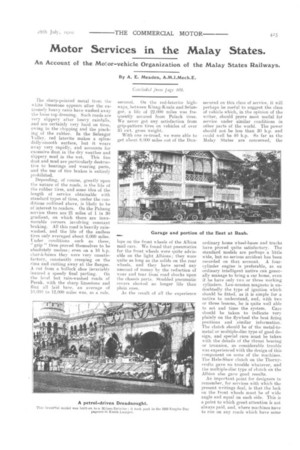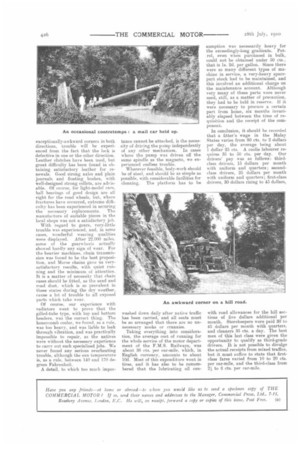Motor Services in the Malay States.
Page 3

Page 4

If you've noticed an error in this article please click here to report it so we can fix it.
An Account of the MWor-vehicle Organization of the Malay States Railways.
By A. E. Meaden, A.M.I.Mech.E.
The sharp-pointed metal from the white limestone appears after the extremely heavy rains have washed away the loose top dressing. Such roads are very slippery after heavy rainfalls, and are certainly very hard on tires, owing to the chipping and the pinching of the rubber. In the Selangor Valley, red laterite makes a splendidly-smooth surface, but it wears away very rapidly, and accounts for excessive dust in the dry weather and slippery mud in the wet. This fine dust and mud are particularly destructive to bearings and wearing parts, and the use of tire brakes is entirely prohibited.
Depending, of course, greatly upon the nature of the roads, is the life of the rubber tires, and some idea of the length of service obtainable with standard types of tires, under the conditions outlined above, is likely to be of interest to readers. On the Pahang service there are 21 miles of 1 in 30 gradient, on which there are innumerable corners involving constant braking. All this road is heavily rainwashed, and the life of the endless tires only averaged about 6,000 miles. I'nder conditions such as these, grip " tires proved themselves to be absolutely useless; even on a 16 h.p. char-k-bancs they were very unsatisfactory, constantly creeping on the rims and cutting away at the flanges. A cut from a bullock shoe invariably
insured a speedy final parting. On the level but rain-washed roads of Perak. with the sharp limestone and flint all laid hare, an average of 10.000 to 12,000 miles was, as a rule.
secured. On the red-laterite highways, between Kiang-Kuala and Selangor, a life of 22,000 miles was frequently secured from Polack tires. We never got any satisfaction from grip-pattern tires on vehicles of over 35 cwt. gross weight.
With one re-tread, we were able to get about 8,000 miles out of the Dun lops on the front wheels of the Albion mail cars. We found that pneumatics for the front wheels were quite advisable on the light Alhions; they wore quite as long as the solids on the rear wheels, and they have saved any amount of money by the reduction of wear and tear from road shocks upon the chassis parts. Studded pneumatic covers showed no longer life than plain ones.
As the result of all the experience secured on this class of service, it will perhaps be useful to suggest the class of vehicle which, in the opinion of the writer, should prove most useful for service under similar conditions in other parts of the world. The power should not be less than 30 h.p. and could well be 40 h.p. So far as the Malay States are concerned, the ordinary home wheel-bases and tracks have proved quite satisfactory. The standard models are perhaps a little wide, but no serious accident has been recorded on that account. A four. cylinder engine is preferable, as an ordinary intelligent native can generally manage to bring a car home, even if he have only two or three working cylinders. Low-tension magneto is undoubtedly the type of ignition which should be fitted, as it is simple for a native to understand, and, with two or three lessons, he is quite well able to set. and time the system. Care should be taken to indicate very plainly on the flywheel the best firing positions and similar information. The clutch should be of the metal-tometal or multiple-disc type of good design, and special care must be taken with the details of the thrust bearing or trunnion, as considerable trouble was experienced with the design of this component on some of the machines. The Hele-Shaw clutch on the Thornycrofts gave no trouble whatever, and the multiple-disc type of clutch on the Albion also gave good results.
An important point for designers to remember, for services with which the present writings deal, is that the lock on the front wheels must be of wide angle and equal On each side. This is a point to which great attention is not always paid, and, where machines have to run on any roads which have some exceptionally-awkward corners in both directions, trouble will be experienced from the fact that the lock is defective in one or the other direction. Leather clutches have been used, but great difficulty has been found in obtaining satisfactory leather for renewals. Good strong axles and plain journals and floating bushes, with well-designed strong collets, are advisable. Of course, for light-model cars. ball bearings of good design are all right for the road wheels, but, where fractures have occurred, extreme difficulty has been experienced in securing the necessary replacements. The manufacture of suitable pieces in the local shops was not a satisfactory job.
With regard to gears, very-little trouble was experienced, and, in some cases, wonderful wearing qualities were displayed. After 22.000 miles, some of the gearwheels actually showed hardly any sign of wear. For the heavier machines, chain transmission was found to be the best proposition, and Morse chains gave us verysatisfactory results, with quiet running and the minimum of attention. Tt is a matter of necessity that chain eases should be fitted, as the sand and road dust, which is so prevalent in these states during the dry weather, cause a lot of trouble to all exposed parts which take wear.
Of course, our experience with radiators went to prove that the gilled-tube type, with top and bottom headers, was the correct thing. The honeycomb cooler, we found, 26 a rule, was too heavy, and was liable to leak through vibration, and was practically impossible to repair, as the natives were without the necessary experience to carry out such specialized jobs. We never found any serious overheating trouble, although the sun temperature is, as a rule, between 140 and 170 degrees Fahrenheit.
A detail, to which too much impor
Lance cannot be attached, is the necessity of driving the pump independently of any other mechanism. In cases where the pump was driven off the same spindle as the magneto, we experienced endless trouble. Wherever feasible, body-work should be of steel, and should be as simple as possible, with considerable facilities for cleaning. The platform has to be
washed down daily after native traffic has been carried, and all seats must be so arranged that there are no unnecessary nooks or crannies.
Taking everything into oonsideration, the average cost of running for the whole service of the motor department of the F.M.S. Railways, was about 36 eta, per car-mile, which, in English currency, amounts to about 10d. Most of this expenditure went in tires, and it has also to be remembered that the lubricating oil con sumption was necessarily heavy for the exceedingly-long gradients. Petrol, even when purchased in bulk, could not be obtained under 50 eta., that is Is. 2d. per gallon. Since there were so many different types of machine in service, a very-heavy sparepart stock had to be maintained, and this involved an additional charge on the maintenance account. Although very many of these parts were never used, still, as a matter of precaution, they had to be held in reserve. If it were necessary to procure a certain part from home, six months invariably elapsed between the time of requisition and the receipt of the component.
In conclusion, it should be recorded that a fitter's wage in the Malay States varies from 80 cts. to 2 dollars per day, the average being about 1 dollar 25 cts. A coolie labourer requires 35 to 50 ets, per day. Our drivers' pay was as follows: thirdclass drivers, 15 dollars per month with uniform and quarters ; secondclass drivers, 25 dollars per month with uniform and quarters; first-class drivers, 30 dollars rising to 45 dollars,
with road allowances for the hill sections of five dollars additional per month. Storekeepers were paid 30 to 45 dollars per month with quarters, and cleaners 35 cts. a day. The best men of this last class were given the opportunity to qualify as third-grade drivers. It is not possible to divulge the actual receipts from mixed traffics, but it must suffice to state that firstclass fares varied from 10 to 20 eta. per car-mile, and the third-class from 21 to 6 cts. per ear-mile.




















